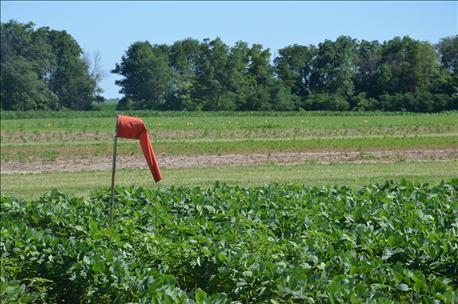
Whether you like big ag companies or not, most of you would agree you need products they produce. One big need is for herbicides that can stop resistant weeds, including marestail, giant ragweed and Palmer amaranth. The herbicides are ready and waiting. But very few acres are being sprayed with them because companies are waiting on EPA approval.

PLOTS AND MORE PLOTS: Ag companies have submitted reams of data collected from plots similar to this one on the Dow AgroSciences farm near Sheridan. Now it’s time for EPA to act.
The new batch of products includes herbicides to control weeds in Enlist corn and soybeans from Dow AgroSciences and in the Xtend system from Monsanto. Dow AgroSciences’ product is a new formulation of 2,4-D that has the weed-killing power of 2,4-D, but not the typical drift and volatilization issues. Monsanto’s system relies on dicamba, reformulated with what’s known as VaporGrip technology. Two other companies, BASF and DuPont, have introduced their own versions of dicamba.
Insiders say they thought these products would have approval long before now. As one person says, “The rules seemed to change when we got to these products.”
In the past, the regulatory process was long and arduous but somewhat predictable. After submission of reams of data, if there were no glaring issues, EPA issued a label.
“This time the process seems to go on and on,” the person says. “We’ve been talking about our product for four years, thinking farmers would have it in their hands in a couple years. It hasn’t happened.”
Changing climate
One year ago I attended a field day where the company asked growers raising new Enlist soybeans for seed to answer questions. The farmers were growing seed beans that would presumably be planted in 2016. The winter came and went without the anticipated label. This year at the same field day, there were no farmers to talk to about growing seed. Things have come to a halt.
That’s led one insider to say working with EPA at this point is like slamming into a brick wall. Whether it’s politics, and the current administration has decided to punt the topic to the next administration, isn’t clear. What is obvious is that approvals aren’t coming, even on the somewhat irregular basis as before.
Unintended consequences
In the meantime, farmers in the most desperate situations apparently aren’t waiting for approvals. Several reports of dicamba injury are coming out of the Deep South. University experts there suspect it’s from illegal application of currently available forms of dicamba on soybeans and cotton that have the trait.
That underscores the urgency of the situation, but likely won’t help the registration process. And besides the failure of EPA to label these herbicides, companies are still also awaiting on export approvals from China and the European Union for some grain products.
Hopefully the next federal administration will put common sense back into the process. Companies acted in good faith, investing in products they felt would meet farmer needs, and yes, net a profit in the process. The need for these products is obvious. Weeds aren’t waiting for EPA. And processes that lead to more resistant weeds are underway right now across the U.S.
Companies and farmers deserve resolution, one way or the other. If the data supports safe use of these products, it’s time EPA gives the green light to go after weeds with the best tools available.
About the Author(s)
You May Also Like




